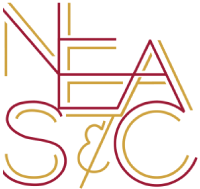On Thursday, my field lab group put on some bog boots, piled into two big Chewonki vans, and headed to check out the intertidal life and collection of ancient rocks that Pemaquid Point has to offer! It was a bright, crisp day, and when we got out of the vans after a half hour of friendship bracelet making and singing along to some Phoebe Bridgers with Megan, our Natural History teacher, we were greeted with the dazzling blue of the ocean and gusts of fresh, salty air. Led by Megan, Lucy, and Chloe (appropriately dubbed “team science”), we carefully made our way over some steep boulders and out on to the point, hand lenses and binoculars around our necks. I gazed out on the expanse of sparkling tide pools and long, grooved rocks in wonder, and immediately decided that this was, by far, my favorite field lab spot yet.
For the next hour, we split into two groups. One headed off to learn about the formation of the point’s rocks, and the other took some time exploring the intertidal zone and the life that it houses. I started off with geology, where we talked about the two different types of rocks that we were sitting on–the metamorphic rock Gneiss and the igneous rock Quartz–and how they formed hundreds of millions of years ago! We jotted down some questions and observations as per usual in our yellow field journals as we discussed, and even made some small but very informative diagrams about the way the rocks got there.
Next, my group went over to the collection of clear tide pools, which were filled with at least five different species of algae, periwinkle snails, hundreds of barnacles, and pearly blue mussels. We watched as tiny little barnacles fed themselves using their “arms,” and tried to identify the different kinds of algae that we knew (we got one of them that happened to be on this week’s species quiz!), all the while bombarding Chloe with questions about all the different parts of the tide pools and the point, who did her very best to answer them all!
After working some more on our field lab entries, we had some time to explore on our own. I wandered from pool to pool examining the life in each one and exclaiming with my friends over the beautiful, intricate specimens in each. We all felt a real connection to this phenomenal place and joked about wanting to stay there forever.
After a pit stop at the Pemaquid lighthouse for some more exploration and a quick photo op on a big Quartz boulder, the Thursday field lab group arrived back on Chewonki Neck, exhausted, cold, and windblown but delighted after a very successful afternoon spent experiencing the magic of coastal Maine!
Lucia Frank, Friends Seminary, New York, NY













